Home / Gilman Reagents (Organocuprates): What They’re Used For
Organometallics
Gilman Reagents (Organocuprates): What They’re Used For
Last updated: February 28th, 2025 |
So What Are Gilman Reagents Used For, Anyway?
Last time we talked about how to make Gilman reagents (organocuprates). In this post, we’ll talk about what they’re actually used for.
Gilman reagents have some useful contrasts to Grignard reagents.
- First of all, they can be used to perform conjugate addition reactions (“1,4-addition”) on alpha,-beta unsaturated ketones. In contrast, Grignard reagents tend to only add to the carbonyl carbon.
- Secondly, Gilman reagents are useful nucleophiles for SN2 reactions, forming C-C bonds with primary alkyl halides and sulfonates (e.g. tosylates, mesylates)
- Third, Gilman reagents will convert acid halides to ketones through nucleophilic acyl substitution. Grignard reagents will add twice to acid halides to give tertiary alcohols.
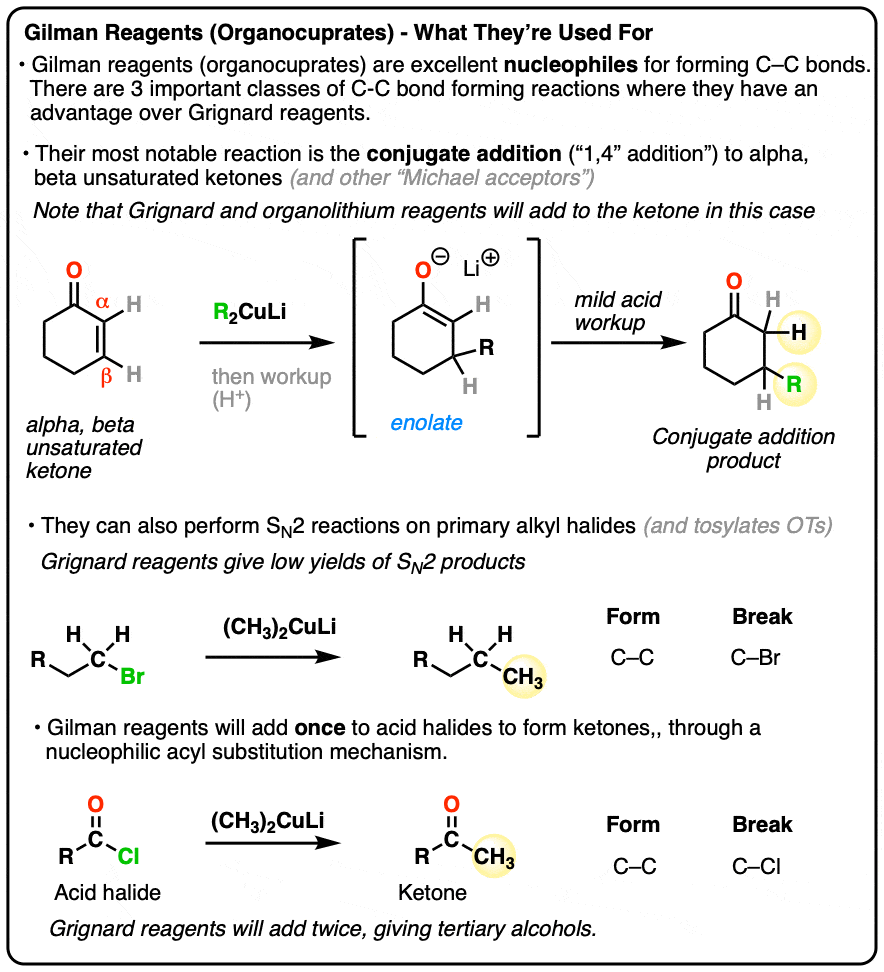
Table of Contents
- Gilman Reagents vs Grignard Reagents
- Conjugate Addition: A Key Reaction of Gilman Reagents
- How do you know whether “normal” or “conjugate” addition will occur?
- Conjugate Addition Mechanism
- Gilman Reagents Are Great Nucleophiles For SN2 Reactions
- Conclusion: Gilman Reagents
- Notes
- Quiz Yourself!
- (Advanced) References and Further Reading
1. Gilman Reagents vs. Grignard Reagents
As I hinted at last time, Gilman reagents provide an interesting contrast with Grignard and organolithium reagents.
Remember all those examples of Grignard reagents adding to aldehydes, ketones, and esters? Well, Gilman reagents don’t generally do that (they will add to acid chlorides, but I digress)

You might find yourself wondering, “So what?”. Why do we have to bother learning about these things if they’re not even very reactive?
Well, dear reader, let me fill you in on a second example. We’ll change one small thing, and everything changes.
Let’s put a double bond next to the ketone and run the reaction again.
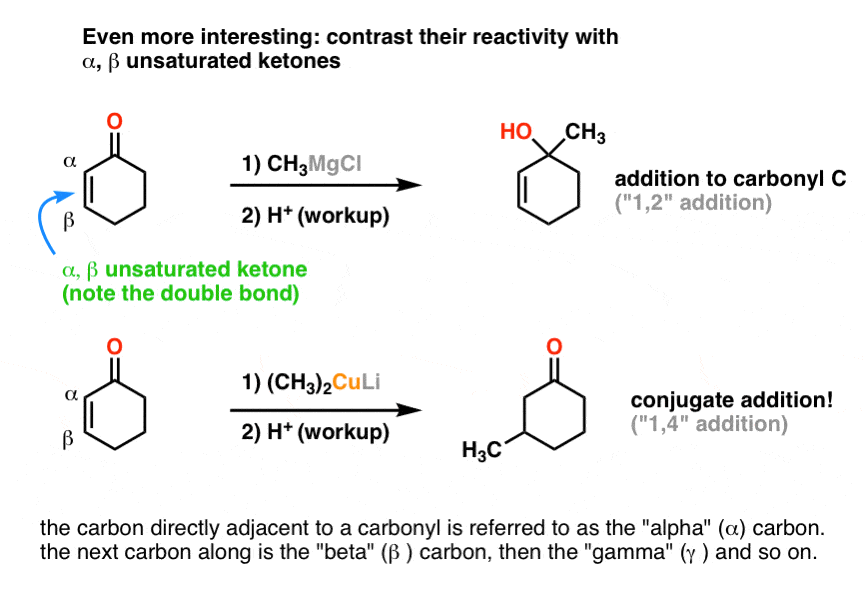
Whoa. What just happened there?
2. Conjugate Addition: A Key Reaction of Gilman Reagents
The Grignard reagent reacted the same way (to the carbonyl) but for the organocuprate, see that we’ve broken the C-C π bond (double bond) and formed a new C-C bond ?
If that seems strange to you, it should! Isolated alkenes, such as cyclohexene, for instance, don’t do this reaction.

So there must be something important about the fact that the alkene is next to a carbonyl. Why might that be important?
Look at the resonance forms and you will see a clue.
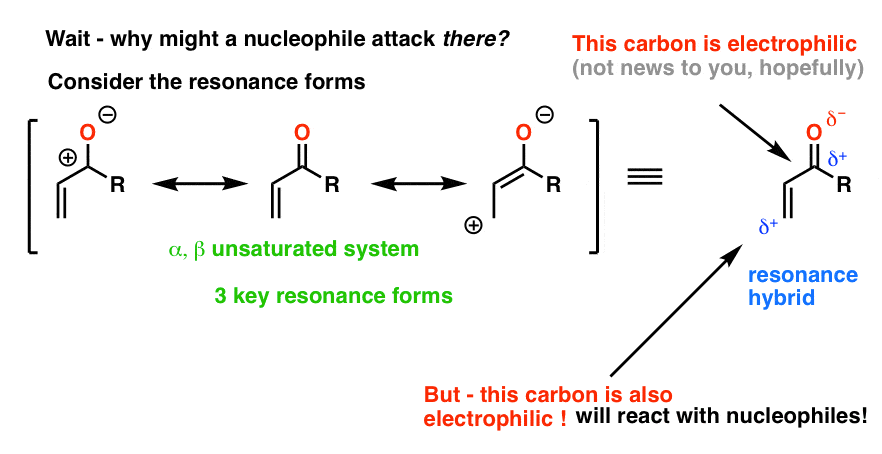
There is an important resonance form where the carbon two carbons away from the carbonyl carbon (we call this the “beta” (β) position) bears a positive charge. In the resonance hybrid, therefore, that carbon bears some partial positive charge.
In other words, that carbon is electrophilic. It can react with nucleophiles! (Such as organocuprates).
Contrast that with ordinary alkenes, where the resonance form with a carbon bearing a negative charge is not an important resonance form. The fact that the charge is placed on oxygen in the resonance form of an α,β unsaturated system is the key to the relative importance of that resonance form. [Compare the basicity of alkoxides (RO-) and alkyllithiums (R-) and that will give you an idea of their relative stabilities].

[For more, see article – The Michael Addition and Conjugate Addition]
3. Wait: How Do You Know Whether “Normal” Addition or “Conjugate” Addition Will Occur?
This brings up an important question: How do you know whether a nucleophile will attack at the carbonyl carbon (sometimes called “1,2 addition” in our jargon) or at the beta position (“1,4 addition” or “conjugate addition”).
Simple question. Very difficult to answer succinctly, and too big a topic for this post.
Short answer: memorize that Grignards add to carbonyls, while organocuprates do conjugate addition.
(ducks while people throw things at the screen)
I only say “memorize” because in order to adequately understand this phenomenon, we’d have to go into some molecular orbital theory to get at the key concept of “Hard Soft Acid Base (HSAB) Theory“, and at this point, we’re not going to cover it.
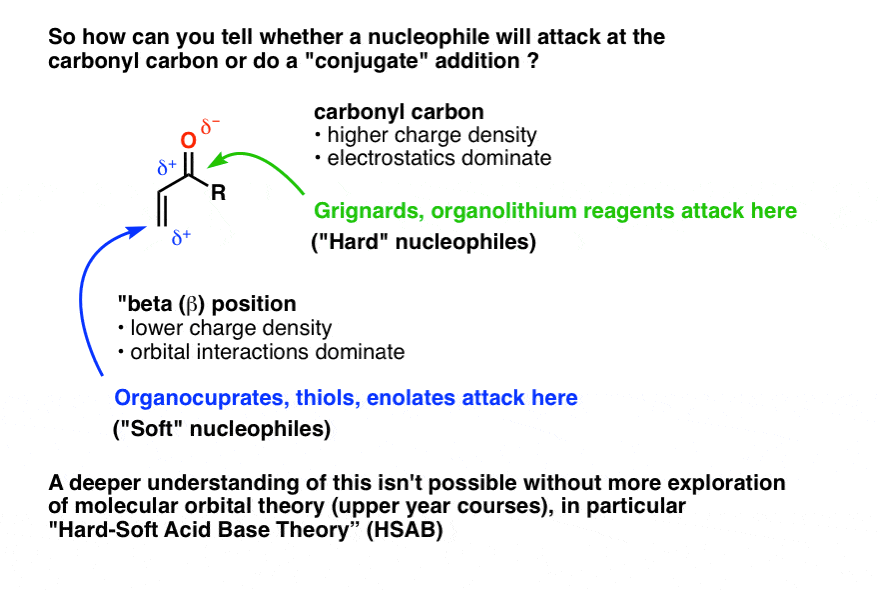
What about the mechanism of the reaction? Now that’s something we can cover.
4. Conjugate Addition Mechanism
In the first step, the nucleophile (which is the pair of electrons in the Cu-CH3 bond, NOT the negative charge on copper!) forms a bond with the beta position of the ketone. The C-C π bond breaks, forming a negative charge on the alpha carbon. We can actually go further and draw a resonance form where we form a new C-C π bond and place the negative charge on oxygen. You’ll see this chemical species a lot in subsequent chapters – it’s called an enolate, and it’s very important. (See article: Enolates)
For now, the key takeaway is that the negative charge is on the oxygen, which is considerably more stable (less basic) than having a negative charge on carbon.
Adding acid will protonate the enolate (which is a base, after all) and result in our final product.
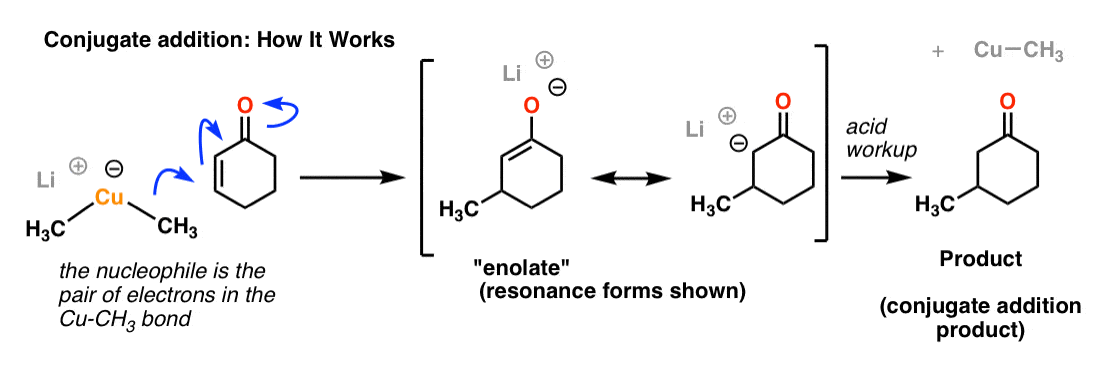
5. Gilman Reagents Are Excellent Nucleophiles For SN2 Reactions
But wait! Conjugate additions aren’t all organocuprates can do.
If you have a keen eye for the other posts in this series, you might have noticed that SN2 reactions were conspicuously absent on the list of reactions that Grignards are useful for. [Why’s that? Great question. The short answer is, we observe that a lot of side reactions tend to occur, like deprotonation and reduction. Using a Grignard reagent to do an SN2 reaction to form a C-C bond is generally not a great process].
However, once we switch to a Gilman reagent, the SN2 works well. This is a handy reaction to have in the toolbox for forming C-C bonds.
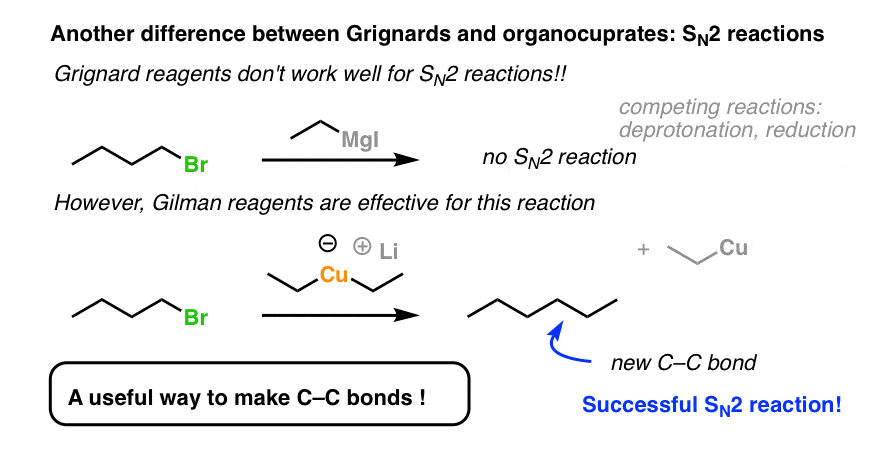
That about sums it up for Gilman reagents right now. We could add that they can be used to make ketones from acid halides , I hesitate to put that in at the moment, given that this post is long enough as it is. [The general mechanism is covered in this article on Nucleophilic Acyl Substitution. ]
6. Conclusion: Gilman Reagents
Gilman reagents (organocuprates) perform two reactions that Grignard reagents (and organolithiums) do not:
• They perform conjugate additions to α,β unsaturated ketones.
• They are effective nucleophiles for SN2 reactions.
In the next post, we’ll change to a more controversial topic – transition metal catalyzed reactions.
Next Post: Heck, Suzuki, and Olefin Metathesis Reactions
Notes
Related Articles
- The Michael Addition Reaction and Conjugate Addition
- The Heck, Suzuki, and Olefin Metathesis Reactions (And Why They Don’t Belong In Most Introductory Organic Chemistry Courses)
- 1,4-addition of organocuprates (Gilman reagents) to enones
- SN2 reaction of organocuprates (Gilman reagents) with alkyl halides to give alkanes (MOC Membership)
- Organocuprates (Gilman Reagents): How They’re Made
- Enolates – Formation, Stability, and Simple Reactions
- Exploring Resonance: Pi-acceptors
Note 1. Yet More Information, Because This Hasn’t Been A Long Enough Blog Post Already
Here’s a quiz for you. What would be the better nucleophile? An organocopper reagent or an organocuprate reagent?

When thinking about this, analyze the leaving group. Therein lies the clue.
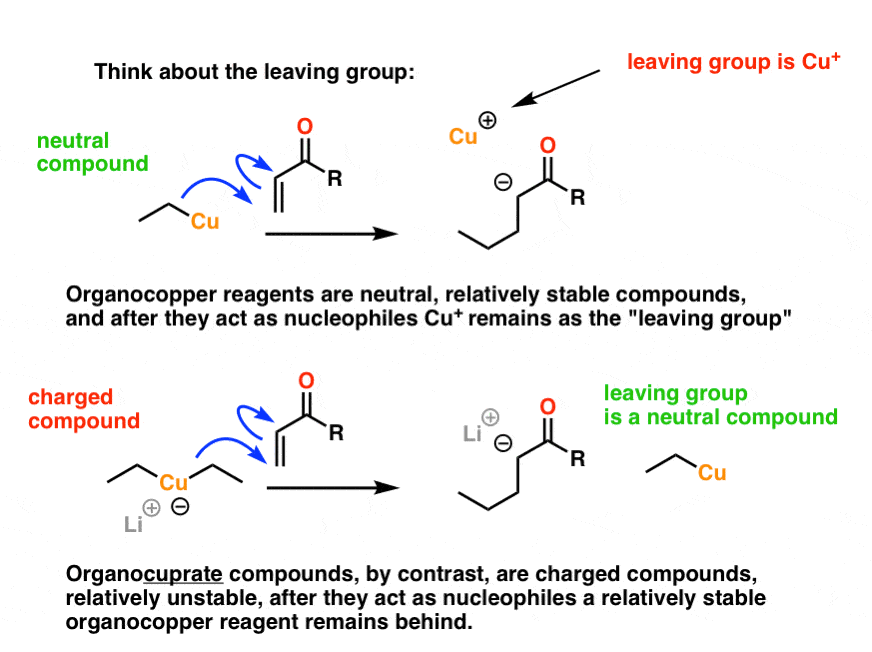
When organocopper reagents act as nucleophiles, they go from neutral, relatively stable compounds to ionic Cu+. Although this is a sweeping generalization, charge minimization is generally associated with greater stability in organic chemistry. We’re going from a neutral compound (organocopper) to a charged ion (Cu+). [I could also add that Cu+, being a soft ion, is not very effective in binding to O-, but that’s a pretty advanced point].
Compare that to organocuprates. There, we’re starting as a relatively unstable charged species, and our final copper product is the neutral organocopper reagent. This is definitely downhill in terms of stability. It’s reasonable to expect that the organocuprate will be more reactive, and hence be a better nucleophile.
The same principle can be used to explain why NaBH4 is a better reducing agent than BH3, and LiAlH4 is a better reducing agent than AlH3.
Quiz Yourself!
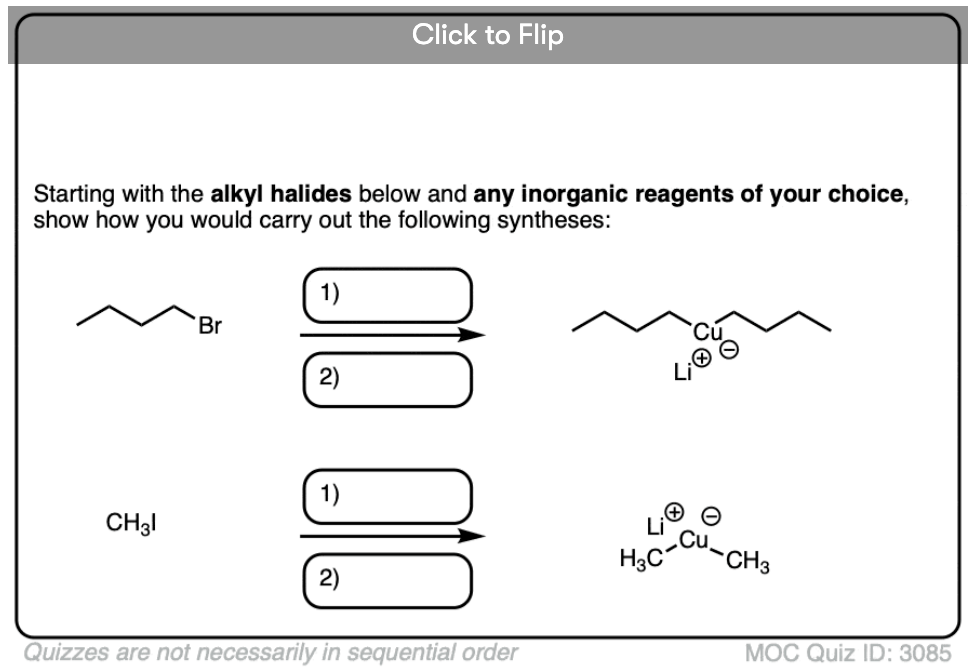
Become a MOC member to see the clickable quiz with answers on the back.
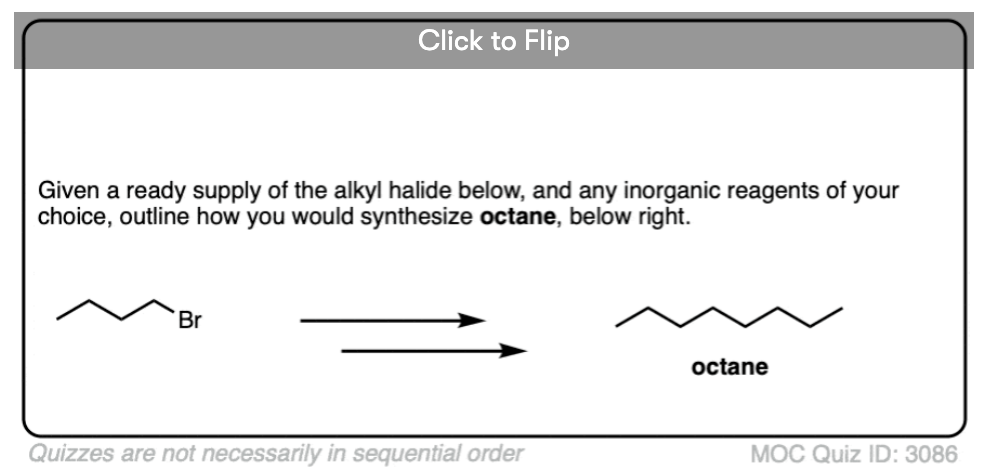
Become a MOC member to see the clickable quiz with answers on the back.
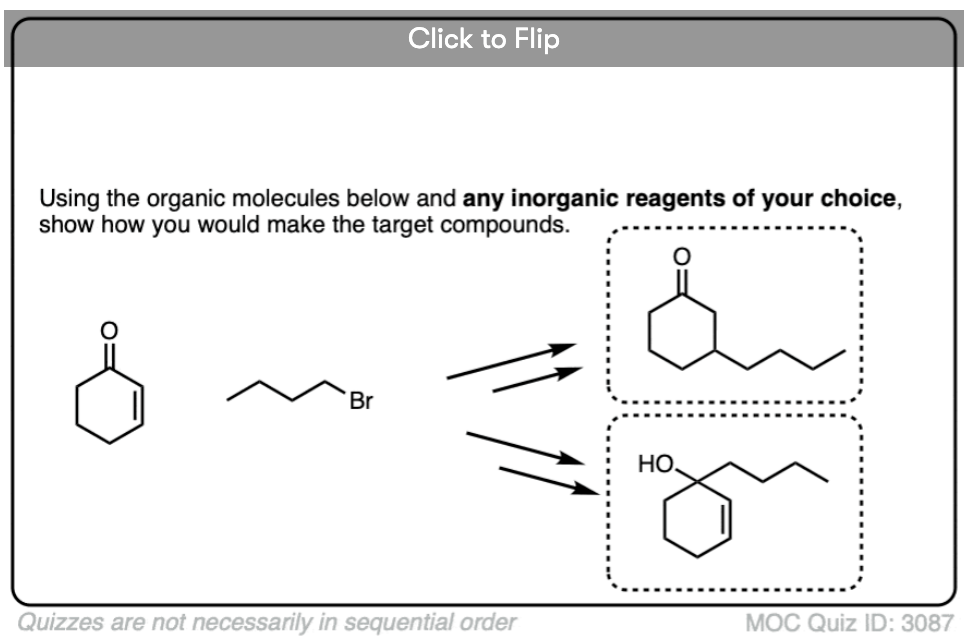
Become a MOC member to see the clickable quiz with answers on the back.
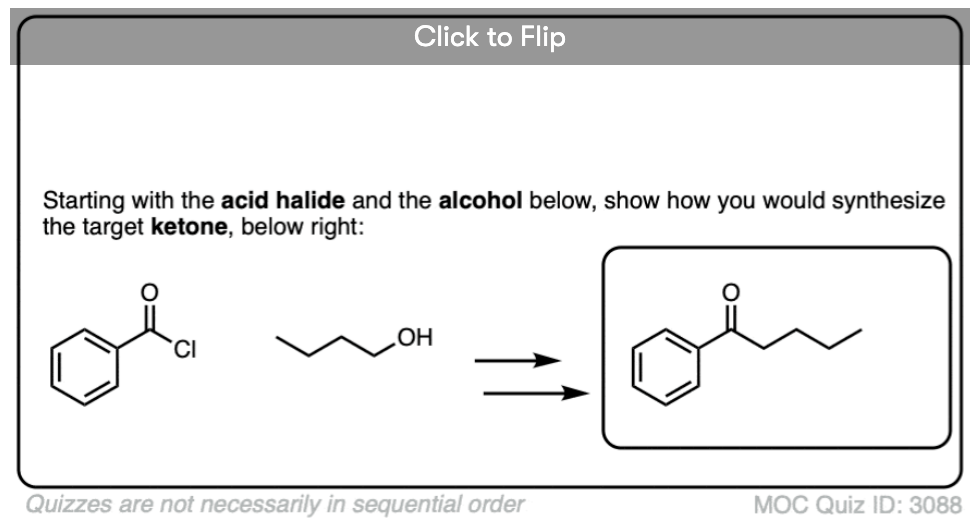
Become a MOC member to see the clickable quiz with answers on the back.
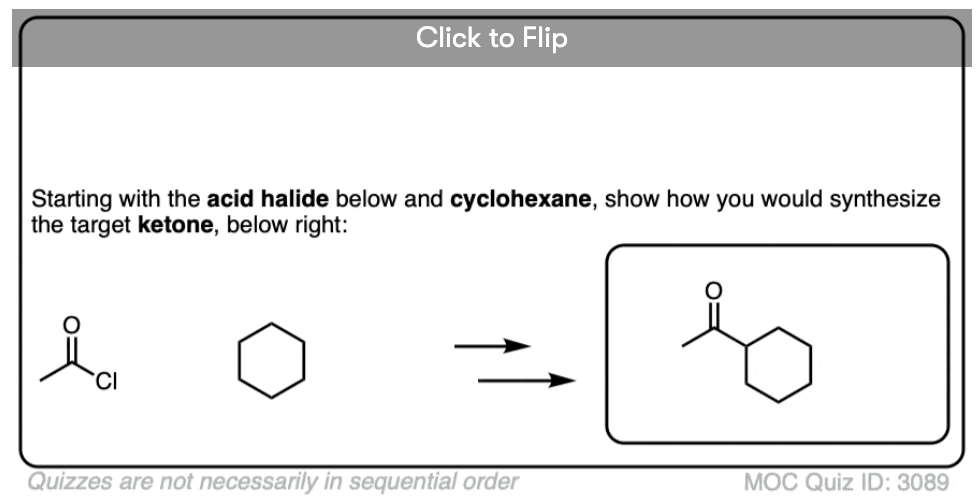
Become a MOC member to see the clickable quiz with answers on the back.
(Advanced) References and Further Reading
Gilman reagents, or Lithium organocuprates (R2CuLi), are useful nucleophiles in organic synthesis. These have a different reactivity from Grignard reagents and organolithiums, since Gilman reagents are softer.
Gilman reagent formation:
- The Preparation of Methylcopper and some Observations on the Decomposition of Organocopper Compounds
Henry Gilman, Reuben G. Jones, and L. A. Woods
The Journal of Organic Chemistry 1952 17 (12), 1630-1634
DOI:1021/jo50012a009
One of the first papers by Prof. Henry Gilman (U. of Iowa) on ‘Gilman Reagents’ – diorganocopper compounds. In this case he describes the preparation of dimethylcopper.
Conjugate addition of Gilman reagents: - Chemistry of carbanions. XVII. Addition of methyl organometallic reagents to cyclohexenone derivatives
Herbert O. House and William F. Fischer Jr.
The Journal of Organic Chemistry 1968 33 (3), 949-956
DOI: 1021/jo01267a004 - Conjugate Addition Reactions of Organocopper Reagents
Gary H. Posner
React. 1972, 19, 1-114
DOI: 10.1002/0471264180.or019.01
Organic Reactions is a series of reviews maintained by the ACS Division of Organic Chemistry, and this review by Prof. Posner, a specialist in cuprate chemistry, covers everything you’d want to know about conjugate additions with copper, as of 1972. Detailed experimental procedures are given towards the end.Ketones can be synthesized by the addition of Gilman reagents to acyl halides: - Methyl and -alkyl ketones from carboxylic acid chlorides and organocopper reagents
G. H. Posner, C. E. Whitten
Tetrahedron. Lett. 1970, 11 (53), 4647-4650
DOI: 10.1016/S0040-4039(00)89398-3
One of the original papers on this reaction. Prof. Posner has done a lot of work studying organocopper chemistry in his career. - Organocopper chemistry. Halo-, cyano-, and carbonyl-substituted ketones from the corresponding acyl chlorides and organocopper reagents
Gary H. Posner, Charles E. Whitten, and Paul McFarland
Journal of the American Chemical Society 1972, 94 (14), 5106-5108
DOI: 1021/ja00769a066
An extension of the previous paper, expanding the substrate scope of the reaction.The SN2 reaction of Gilman reagents with alkyl halides is also known as the Corey-Posner-Whitesides-House reaction: - Selective formation of carbon-carbon bonds between unlike groups using organocopper reagents
Elias J. Corey and Gary H. Posner
Journal of the American Chemical Society 1967, 89 (15), 3911-3912
DOI: 1021/ja00991a049
Nobel Laureate Prof. E. J. Corey first describes the reaction of Gilman reagents from CH3Li ((CH3)2CuLi) with alkyl and aryl halides to form new C-C bonds. - Carbon-carbon bond formation by selective coupling of n-alkylcopper reagents with organic halides
Elias J. Corey and Gary H. Posner
Journal of the American Chemical Society 1968, 90 (20), 5615-5616
DOI: 1021/ja01022a058
Prof. Corey extends this method to n-butyl and ethyl (from n-BuLi and EtLi) as well. - Reaction of lithium dialkyl- and diarylcuprates with organic halides
George M. Whitesides, William F. Fischer Jr., Joseph San Filippo Jr., Robert W. Bashe, and Herbert O. House
Journal of the American Chemical Society 1969, 91 (17), 4871-4882
DOI: 1021/ja01045a049
Classic paper by Prof. G. M. Whitesides (MIT, now Harvard) on the coupling of Gilman reagents (R2CuLi) with aryl iodides. This reaction is exhaustively studied, and features a thorough mechanistic investigation, which is why his name is included in the reaction.
00 General Chemistry Review
01 Bonding, Structure, and Resonance
- How Do We Know Methane (CH4) Is Tetrahedral?
- Hybrid Orbitals and Hybridization
- How To Determine Hybridization: A Shortcut
- Orbital Hybridization And Bond Strengths
- Sigma bonds come in six varieties: Pi bonds come in one
- A Key Skill: How to Calculate Formal Charge
- The Four Intermolecular Forces and How They Affect Boiling Points
- 3 Trends That Affect Boiling Points
- How To Use Electronegativity To Determine Electron Density (and why NOT to trust formal charge)
- Introduction to Resonance
- How To Use Curved Arrows To Interchange Resonance Forms
- Evaluating Resonance Forms (1) - The Rule of Least Charges
- How To Find The Best Resonance Structure By Applying Electronegativity
- Evaluating Resonance Structures With Negative Charges
- Evaluating Resonance Structures With Positive Charge
- Exploring Resonance: Pi-Donation
- Exploring Resonance: Pi-acceptors
- In Summary: Evaluating Resonance Structures
- Drawing Resonance Structures: 3 Common Mistakes To Avoid
- How to apply electronegativity and resonance to understand reactivity
- Bond Hybridization Practice
- Structure and Bonding Practice Quizzes
- Resonance Structures Practice
02 Acid Base Reactions
- Introduction to Acid-Base Reactions
- Acid Base Reactions In Organic Chemistry
- The Stronger The Acid, The Weaker The Conjugate Base
- Walkthrough of Acid-Base Reactions (3) - Acidity Trends
- Five Key Factors That Influence Acidity
- Acid-Base Reactions: Introducing Ka and pKa
- How to Use a pKa Table
- The pKa Table Is Your Friend
- A Handy Rule of Thumb for Acid-Base Reactions
- Acid Base Reactions Are Fast
- pKa Values Span 60 Orders Of Magnitude
- How Protonation and Deprotonation Affect Reactivity
- Acid Base Practice Problems
03 Alkanes and Nomenclature
- Meet the (Most Important) Functional Groups
- Condensed Formulas: Deciphering What the Brackets Mean
- Hidden Hydrogens, Hidden Lone Pairs, Hidden Counterions
- Don't Be Futyl, Learn The Butyls
- Primary, Secondary, Tertiary, Quaternary In Organic Chemistry
- Branching, and Its Affect On Melting and Boiling Points
- The Many, Many Ways of Drawing Butane
- Wedge And Dash Convention For Tetrahedral Carbon
- Common Mistakes in Organic Chemistry: Pentavalent Carbon
- Table of Functional Group Priorities for Nomenclature
- Summary Sheet - Alkane Nomenclature
- Organic Chemistry IUPAC Nomenclature Demystified With A Simple Puzzle Piece Approach
- Boiling Point Quizzes
- Organic Chemistry Nomenclature Quizzes
04 Conformations and Cycloalkanes
- Staggered vs Eclipsed Conformations of Ethane
- Conformational Isomers of Propane
- Newman Projection of Butane (and Gauche Conformation)
- Introduction to Cycloalkanes
- Geometric Isomers In Small Rings: Cis And Trans Cycloalkanes
- Calculation of Ring Strain In Cycloalkanes
- Cycloalkanes - Ring Strain In Cyclopropane And Cyclobutane
- Cyclohexane Conformations
- Cyclohexane Chair Conformation: An Aerial Tour
- How To Draw The Cyclohexane Chair Conformation
- The Cyclohexane Chair Flip
- The Cyclohexane Chair Flip - Energy Diagram
- Substituted Cyclohexanes - Axial vs Equatorial
- Ranking The Bulkiness Of Substituents On Cyclohexanes: "A-Values"
- Cyclohexane Chair Conformation Stability: Which One Is Lower Energy?
- Fused Rings - Cis-Decalin and Trans-Decalin
- Naming Bicyclic Compounds - Fused, Bridged, and Spiro
- Bredt's Rule (And Summary of Cycloalkanes)
- Newman Projection Practice
- Cycloalkanes Practice Problems
05 A Primer On Organic Reactions
- The Most Important Question To Ask When Learning a New Reaction
- Curved Arrows (for reactions)
- Nucleophiles and Electrophiles
- The Three Classes of Nucleophiles
- Nucleophilicity vs. Basicity
- What Makes A Good Nucleophile?
- What Makes A Good Leaving Group?
- 3 Factors That Stabilize Carbocations
- Equilibrium and Energy Relationships
- 7 Factors that stabilize negative charge in organic chemistry
- 7 Factors That Stabilize Positive Charge in Organic Chemistry
- What's a Transition State?
- Hammond's Postulate
- Learning Organic Chemistry Reactions: A Checklist (PDF)
- Introduction to Oxidative Cleavage Reactions
06 Free Radical Reactions
- Free Radical Reactions
- 3 Factors That Stabilize Free Radicals
- Bond Strengths And Radical Stability
- Free Radical Initiation: Why Is "Light" Or "Heat" Required?
- Initiation, Propagation, Termination
- Monochlorination Products Of Propane, Pentane, And Other Alkanes
- Selectivity In Free Radical Reactions
- Selectivity in Free Radical Reactions: Bromination vs. Chlorination
- Halogenation At Tiffany's
- Allylic Bromination
- Bonus Topic: Allylic Rearrangements
- In Summary: Free Radicals
- Synthesis (2) - Reactions of Alkanes
- Free Radicals Practice Quizzes
07 Stereochemistry and Chirality
- Types of Isomers: Constitutional Isomers, Stereoisomers, Enantiomers, and Diastereomers
- How To Draw The Enantiomer Of A Chiral Molecule
- How To Draw A Bond Rotation
- Introduction to Assigning (R) and (S): The Cahn-Ingold-Prelog Rules
- Assigning Cahn-Ingold-Prelog (CIP) Priorities (2) - The Method of Dots
- Enantiomers vs Diastereomers vs The Same? Two Methods For Solving Problems
- Assigning R/S To Newman Projections (And Converting Newman To Line Diagrams)
- How To Determine R and S Configurations On A Fischer Projection
- The Meso Trap
- Optical Rotation, Optical Activity, and Specific Rotation
- Optical Purity and Enantiomeric Excess
- What's a Racemic Mixture?
- Chiral Allenes And Chiral Axes
- Stereochemistry Practice Problems and Quizzes
08 Substitution Reactions
- Nucleophilic Substitution Reactions - Introduction
- Two Types of Nucleophilic Substitution Reactions
- The SN2 Mechanism
- Why the SN2 Reaction Is Powerful
- The SN1 Mechanism
- The Conjugate Acid Is A Better Leaving Group
- Comparing the SN1 and SN2 Reactions
- Polar Protic? Polar Aprotic? Nonpolar? All About Solvents
- Steric Hindrance is Like a Fat Goalie
- Common Blind Spot: Intramolecular Reactions
- Substitution Practice - SN1
- Substitution Practice - SN2
09 Elimination Reactions
- Elimination Reactions (1): Introduction And The Key Pattern
- Elimination Reactions (2): The Zaitsev Rule
- Elimination Reactions Are Favored By Heat
- Two Elimination Reaction Patterns
- The E1 Reaction
- The E2 Mechanism
- E1 vs E2: Comparing the E1 and E2 Reactions
- Antiperiplanar Relationships: The E2 Reaction and Cyclohexane Rings
- Bulky Bases in Elimination Reactions
- Comparing the E1 vs SN1 Reactions
- Elimination (E1) Reactions With Rearrangements
- E1cB - Elimination (Unimolecular) Conjugate Base
- Elimination (E1) Practice Problems And Solutions
- Elimination (E2) Practice Problems and Solutions
10 Rearrangements
11 SN1/SN2/E1/E2 Decision
- Identifying Where Substitution and Elimination Reactions Happen
- Deciding SN1/SN2/E1/E2 (1) - The Substrate
- Deciding SN1/SN2/E1/E2 (2) - The Nucleophile/Base
- SN1 vs E1 and SN2 vs E2 : The Temperature
- Deciding SN1/SN2/E1/E2 - The Solvent
- Wrapup: The Key Factors For Determining SN1/SN2/E1/E2
- Alkyl Halide Reaction Map And Summary
- SN1 SN2 E1 E2 Practice Problems
12 Alkene Reactions
- E and Z Notation For Alkenes (+ Cis/Trans)
- Alkene Stability
- Alkene Addition Reactions: "Regioselectivity" and "Stereoselectivity" (Syn/Anti)
- Stereoselective and Stereospecific Reactions
- Hydrohalogenation of Alkenes and Markovnikov's Rule
- Hydration of Alkenes With Aqueous Acid
- Rearrangements in Alkene Addition Reactions
- Halogenation of Alkenes and Halohydrin Formation
- Oxymercuration Demercuration of Alkenes
- Hydroboration Oxidation of Alkenes
- m-CPBA (meta-chloroperoxybenzoic acid)
- OsO4 (Osmium Tetroxide) for Dihydroxylation of Alkenes
- Palladium on Carbon (Pd/C) for Catalytic Hydrogenation of Alkenes
- Cyclopropanation of Alkenes
- A Fourth Alkene Addition Pattern - Free Radical Addition
- Alkene Reactions: Ozonolysis
- Summary: Three Key Families Of Alkene Reaction Mechanisms
- Synthesis (4) - Alkene Reaction Map, Including Alkyl Halide Reactions
- Alkene Reactions Practice Problems
13 Alkyne Reactions
- Acetylides from Alkynes, And Substitution Reactions of Acetylides
- Partial Reduction of Alkynes With Lindlar's Catalyst
- Partial Reduction of Alkynes With Na/NH3 To Obtain Trans Alkenes
- Alkyne Hydroboration With "R2BH"
- Hydration and Oxymercuration of Alkynes
- Hydrohalogenation of Alkynes
- Alkyne Halogenation: Bromination and Chlorination of Alkynes
- Oxidation of Alkynes With O3 and KMnO4
- Alkenes To Alkynes Via Halogenation And Elimination Reactions
- Alkynes Are A Blank Canvas
- Synthesis (5) - Reactions of Alkynes
- Alkyne Reactions Practice Problems With Answers
14 Alcohols, Epoxides and Ethers
- Alcohols - Nomenclature and Properties
- Alcohols Can Act As Acids Or Bases (And Why It Matters)
- Alcohols - Acidity and Basicity
- The Williamson Ether Synthesis
- Ethers From Alkenes, Tertiary Alkyl Halides and Alkoxymercuration
- Alcohols To Ethers via Acid Catalysis
- Cleavage Of Ethers With Acid
- Epoxides - The Outlier Of The Ether Family
- Opening of Epoxides With Acid
- Epoxide Ring Opening With Base
- Making Alkyl Halides From Alcohols
- Tosylates And Mesylates
- PBr3 and SOCl2
- Elimination Reactions of Alcohols
- Elimination of Alcohols To Alkenes With POCl3
- Alcohol Oxidation: "Strong" and "Weak" Oxidants
- Demystifying The Mechanisms of Alcohol Oxidations
- Protecting Groups For Alcohols
- Thiols And Thioethers
- Calculating the oxidation state of a carbon
- Oxidation and Reduction in Organic Chemistry
- Oxidation Ladders
- SOCl2 Mechanism For Alcohols To Alkyl Halides: SN2 versus SNi
- Alcohol Reactions Roadmap (PDF)
- Alcohol Reaction Practice Problems
- Epoxide Reaction Quizzes
- Oxidation and Reduction Practice Quizzes
15 Organometallics
- What's An Organometallic?
- Formation of Grignard and Organolithium Reagents
- Organometallics Are Strong Bases
- Reactions of Grignard Reagents
- Protecting Groups In Grignard Reactions
- Synthesis Problems Involving Grignard Reagents
- Grignard Reactions And Synthesis (2)
- Organocuprates (Gilman Reagents): How They're Made
- Gilman Reagents (Organocuprates): What They're Used For
- The Heck, Suzuki, and Olefin Metathesis Reactions (And Why They Don't Belong In Most Introductory Organic Chemistry Courses)
- Reaction Map: Reactions of Organometallics
- Grignard Practice Problems
16 Spectroscopy
- Degrees of Unsaturation (or IHD, Index of Hydrogen Deficiency)
- Conjugation And Color (+ How Bleach Works)
- Introduction To UV-Vis Spectroscopy
- UV-Vis Spectroscopy: Absorbance of Carbonyls
- UV-Vis Spectroscopy: Practice Questions
- Bond Vibrations, Infrared Spectroscopy, and the "Ball and Spring" Model
- Infrared Spectroscopy: A Quick Primer On Interpreting Spectra
- IR Spectroscopy: 4 Practice Problems
- 1H NMR: How Many Signals?
- Homotopic, Enantiotopic, Diastereotopic
- Diastereotopic Protons in 1H NMR Spectroscopy: Examples
- 13-C NMR - How Many Signals
- Liquid Gold: Pheromones In Doe Urine
- Natural Product Isolation (1) - Extraction
- Natural Product Isolation (2) - Purification Techniques, An Overview
- Structure Determination Case Study: Deer Tarsal Gland Pheromone
17 Dienes and MO Theory
- What To Expect In Organic Chemistry 2
- Are these molecules conjugated?
- Conjugation And Resonance In Organic Chemistry
- Bonding And Antibonding Pi Orbitals
- Molecular Orbitals of The Allyl Cation, Allyl Radical, and Allyl Anion
- Pi Molecular Orbitals of Butadiene
- Reactions of Dienes: 1,2 and 1,4 Addition
- Thermodynamic and Kinetic Products
- More On 1,2 and 1,4 Additions To Dienes
- s-cis and s-trans
- The Diels-Alder Reaction
- Cyclic Dienes and Dienophiles in the Diels-Alder Reaction
- Stereochemistry of the Diels-Alder Reaction
- Exo vs Endo Products In The Diels Alder: How To Tell Them Apart
- HOMO and LUMO In the Diels Alder Reaction
- Why Are Endo vs Exo Products Favored in the Diels-Alder Reaction?
- Diels-Alder Reaction: Kinetic and Thermodynamic Control
- The Retro Diels-Alder Reaction
- The Intramolecular Diels Alder Reaction
- Regiochemistry In The Diels-Alder Reaction
- The Cope and Claisen Rearrangements
- Electrocyclic Reactions
- Electrocyclic Ring Opening And Closure (2) - Six (or Eight) Pi Electrons
- Diels Alder Practice Problems
- Molecular Orbital Theory Practice
18 Aromaticity
- Introduction To Aromaticity
- Rules For Aromaticity
- Huckel's Rule: What Does 4n+2 Mean?
- Aromatic, Non-Aromatic, or Antiaromatic? Some Practice Problems
- Antiaromatic Compounds and Antiaromaticity
- The Pi Molecular Orbitals of Benzene
- The Pi Molecular Orbitals of Cyclobutadiene
- Frost Circles
- Aromaticity Practice Quizzes
19 Reactions of Aromatic Molecules
- Electrophilic Aromatic Substitution: Introduction
- Activating and Deactivating Groups In Electrophilic Aromatic Substitution
- Electrophilic Aromatic Substitution - The Mechanism
- Ortho-, Para- and Meta- Directors in Electrophilic Aromatic Substitution
- Understanding Ortho, Para, and Meta Directors
- Why are halogens ortho- para- directors?
- Disubstituted Benzenes: The Strongest Electron-Donor "Wins"
- Electrophilic Aromatic Substitutions (1) - Halogenation of Benzene
- Electrophilic Aromatic Substitutions (2) - Nitration and Sulfonation
- EAS Reactions (3) - Friedel-Crafts Acylation and Friedel-Crafts Alkylation
- Intramolecular Friedel-Crafts Reactions
- Nucleophilic Aromatic Substitution (NAS)
- Nucleophilic Aromatic Substitution (2) - The Benzyne Mechanism
- Reactions on the "Benzylic" Carbon: Bromination And Oxidation
- The Wolff-Kishner, Clemmensen, And Other Carbonyl Reductions
- More Reactions on the Aromatic Sidechain: Reduction of Nitro Groups and the Baeyer Villiger
- Aromatic Synthesis (1) - "Order Of Operations"
- Synthesis of Benzene Derivatives (2) - Polarity Reversal
- Aromatic Synthesis (3) - Sulfonyl Blocking Groups
- Birch Reduction
- Synthesis (7): Reaction Map of Benzene and Related Aromatic Compounds
- Aromatic Reactions and Synthesis Practice
- Electrophilic Aromatic Substitution Practice Problems
20 Aldehydes and Ketones
- What's The Alpha Carbon In Carbonyl Compounds?
- Nucleophilic Addition To Carbonyls
- Aldehydes and Ketones: 14 Reactions With The Same Mechanism
- Sodium Borohydride (NaBH4) Reduction of Aldehydes and Ketones
- Grignard Reagents For Addition To Aldehydes and Ketones
- Wittig Reaction
- Hydrates, Hemiacetals, and Acetals
- Imines - Properties, Formation, Reactions, and Mechanisms
- All About Enamines
- Breaking Down Carbonyl Reaction Mechanisms: Reactions of Anionic Nucleophiles (Part 2)
- Aldehydes Ketones Reaction Practice
21 Carboxylic Acid Derivatives
- Nucleophilic Acyl Substitution (With Negatively Charged Nucleophiles)
- Addition-Elimination Mechanisms With Neutral Nucleophiles (Including Acid Catalysis)
- Basic Hydrolysis of Esters - Saponification
- Transesterification
- Proton Transfer
- Fischer Esterification - Carboxylic Acid to Ester Under Acidic Conditions
- Lithium Aluminum Hydride (LiAlH4) For Reduction of Carboxylic Acid Derivatives
- LiAlH[Ot-Bu]3 For The Reduction of Acid Halides To Aldehydes
- Di-isobutyl Aluminum Hydride (DIBAL) For The Partial Reduction of Esters and Nitriles
- Amide Hydrolysis
- Thionyl Chloride (SOCl2) And Conversion of Carboxylic Acids to Acid Halides
- Diazomethane (CH2N2)
- Carbonyl Chemistry: Learn Six Mechanisms For the Price Of One
- Making Music With Mechanisms (PADPED)
- Carboxylic Acid Derivatives Practice Questions
22 Enols and Enolates
- Keto-Enol Tautomerism
- Enolates - Formation, Stability, and Simple Reactions
- Kinetic Versus Thermodynamic Enolates
- Aldol Addition and Condensation Reactions
- Reactions of Enols - Acid-Catalyzed Aldol, Halogenation, and Mannich Reactions
- Claisen Condensation and Dieckmann Condensation
- Decarboxylation
- The Malonic Ester and Acetoacetic Ester Synthesis
- The Michael Addition Reaction and Conjugate Addition
- The Robinson Annulation
- Haloform Reaction
- The Hell–Volhard–Zelinsky Reaction
- Enols and Enolates Practice Quizzes
23 Amines
- The Amide Functional Group: Properties, Synthesis, and Nomenclature
- Basicity of Amines And pKaH
- 5 Key Basicity Trends of Amines
- The Mesomeric Effect And Aromatic Amines
- Nucleophilicity of Amines
- Alkylation of Amines (Sucks!)
- Reductive Amination
- The Gabriel Synthesis
- Some Reactions of Azides
- The Hofmann Elimination
- The Hofmann and Curtius Rearrangements
- The Cope Elimination
- Protecting Groups for Amines - Carbamates
- The Strecker Synthesis of Amino Acids
- Introduction to Peptide Synthesis
- Reactions of Diazonium Salts: Sandmeyer and Related Reactions
- Amine Practice Questions
24 Carbohydrates
- D and L Notation For Sugars
- Pyranoses and Furanoses: Ring-Chain Tautomerism In Sugars
- What is Mutarotation?
- Reducing Sugars
- The Big Damn Post Of Carbohydrate-Related Chemistry Definitions
- The Haworth Projection
- Converting a Fischer Projection To A Haworth (And Vice Versa)
- Reactions of Sugars: Glycosylation and Protection
- The Ruff Degradation and Kiliani-Fischer Synthesis
- Isoelectric Points of Amino Acids (and How To Calculate Them)
- Carbohydrates Practice
- Amino Acid Quizzes
25 Fun and Miscellaneous
- A Gallery of Some Interesting Molecules From Nature
- Screw Organic Chemistry, I'm Just Going To Write About Cats
- On Cats, Part 1: Conformations and Configurations
- On Cats, Part 2: Cat Line Diagrams
- On Cats, Part 4: Enantiocats
- On Cats, Part 6: Stereocenters
- Organic Chemistry Is Shit
- The Organic Chemistry Behind "The Pill"
- Maybe they should call them, "Formal Wins" ?
- Why Do Organic Chemists Use Kilocalories?
- The Principle of Least Effort
- Organic Chemistry GIFS - Resonance Forms
- Reproducibility In Organic Chemistry
- What Holds The Nucleus Together?
- How Reactions Are Like Music
- Organic Chemistry and the New MCAT
26 Organic Chemistry Tips and Tricks
- Common Mistakes: Formal Charges Can Mislead
- Partial Charges Give Clues About Electron Flow
- Draw The Ugly Version First
- Organic Chemistry Study Tips: Learn the Trends
- The 8 Types of Arrows In Organic Chemistry, Explained
- Top 10 Skills To Master Before An Organic Chemistry 2 Final
- Common Mistakes with Carbonyls: Carboxylic Acids... Are Acids!
- Planning Organic Synthesis With "Reaction Maps"
- Alkene Addition Pattern #1: The "Carbocation Pathway"
- Alkene Addition Pattern #2: The "Three-Membered Ring" Pathway
- Alkene Addition Pattern #3: The "Concerted" Pathway
- Number Your Carbons!
- The 4 Major Classes of Reactions in Org 1
- How (and why) electrons flow
- Grossman's Rule
- Three Exam Tips
- A 3-Step Method For Thinking Through Synthesis Problems
- Putting It Together
- Putting Diels-Alder Products in Perspective
- The Ups and Downs of Cyclohexanes
- The Most Annoying Exceptions in Org 1 (Part 1)
- The Most Annoying Exceptions in Org 1 (Part 2)
- The Marriage May Be Bad, But the Divorce Still Costs Money
- 9 Nomenclature Conventions To Know
- Nucleophile attacks Electrophile
27 Case Studies of Successful O-Chem Students
- Success Stories: How Corina Got The The "Hard" Professor - And Got An A+ Anyway
- How Helena Aced Organic Chemistry
- From a "Drop" To B+ in Org 2 – How A Hard Working Student Turned It Around
- How Serge Aced Organic Chemistry
- Success Stories: How Zach Aced Organic Chemistry 1
- Success Stories: How Kari Went From C– to B+
- How Esther Bounced Back From a "C" To Get A's In Organic Chemistry 1 And 2
- How Tyrell Got The Highest Grade In Her Organic Chemistry Course
- This Is Why Students Use Flashcards
- Success Stories: How Stu Aced Organic Chemistry
- How John Pulled Up His Organic Chemistry Exam Grades
- Success Stories: How Nathan Aced Organic Chemistry (Without It Taking Over His Life)
- How Chris Aced Org 1 and Org 2
- Interview: How Jay Got an A+ In Organic Chemistry
- How to Do Well in Organic Chemistry: One Student's Advice
- "America's Top TA" Shares His Secrets For Teaching O-Chem
- "Organic Chemistry Is Like..." - A Few Metaphors
- How To Do Well In Organic Chemistry: Advice From A Tutor
- Guest post: "I went from being afraid of tests to actually looking forward to them".
What happens if there is already an R group on the beta carbon?
Still works! Plenty of examples in this volume: https://onlinelibrary.wiley.com/doi/abs/10.1002/0471264180.or041.02
Beyond acid chlorides, will Gilman reagents add to alkylsulfonyl chlorides like MsCl? I don’t have access to SciFinder or Reaxys and am having a hard time checking to see whether this would be a valid reaction.
Primary alkyl sulfonates work well. SN2 reactions between Gilman reagents and secondary alkyl sulfonates don’t work well. For that matter there are not many good examples of organocuprates reacting with secondary alkyl halides or tosylates.
https://pubs.acs.org/doi/pdf/10.1021/ja00804a039
Hey there, First of all amazing content up there. I am Tirth from India preparing for JEE. I have this doubt in the comparision of leaving group strength which you said. If organocuprate is going from more stability to less stability, it will not tend to perfom that reaction. Then shouldn’t it be less nucleophilic?
I don’t think I understand your question. What reaction are you thinking of doing with organocuprates?
the DOI is correct but the hyperlink is wrong
Fixed, thanks
reference 4 links to the wrong URL, here is the correct one:
https://www.sciencedirect.com/science/article/abs/pii/S0040403900893983
Thank you!
Which one is more reactive Gilman or organolithium? And why??
Reactive towards what, specifically?
Hi sir, can gilmann’s reagent react with all acid derivatives..what about R2Cd ‘s reactivity with them?
Thank you sir..
Gilman reagents can react with acid halides, anhydrides, and (sometimes) thiol esters. Everything else forget about it. Cadmium I believe to be even less reactive. See: https://pubs.acs.org/doi/pdf/10.1021/jo00134a015
Hi James,
Can Gilman reagent act as a nucleophile on reaction with vinyl halides to produce higher alkenes ?
Sort of. For example lithium dimethylcuprate will react with vinyl halides and you can substitute halogens with methyl groups. I’m not sure how well it works with other Gilman reagents.
This is not an SN2 reaction, it’s insertion of Cu into the C-(halogen) bond to get a transient copper(III) species which undergoes reductive elimination to give the substituted alkene.
What you are describing is usually best achieved through a cross-coupling reaction (e.g. check out the Suzuki, Negishi, and Kumada reactions)
Is negative charge on Cu?? Or is Gilman reagent is a co ordination complex???
There is a formal negative charge on Cu, but saying as carbon is more electronegative than Cu, the actual negative charge resides mostly on the carbon. Hence, this is a source of nucleophilic carbon.
Hello!
Can (Br-CH2)2CuLi be used in conjugate addition? I am struggling with determining basicity of this R-group.
Thank You.
No, it wouldn’t be stable at all. The Br would react with the carbanion.
why would the grignard and organolithium reagents readily add to ketones, but diorganocopper lithium reagents do not?
That’s an excellent question. One clue is that Cu is much more electronegative than Li and Mg, so the Cu-C bond has more of a covalent character.
In the example where CH3MgCl reacts with cyclohexanone, won’t it pull out the acidic h at alpha carbon and form CH4?
Thankyou in advance!
You are describing the Grignard reagent acting as a base. This can occur in some cases, such as when a ketone is quite sterically hindered, but under normal conditions the addition reaction tends to be faster.
One subtle point about the deprotonation reaction is that the C-H bond is only reasonably acidic when it is lined up close to 90° relative to the C=O bond, which allows for stabilization of the resulting lone pair by resonance.
Is it the pi star orbital of C=O which stabilizes the lone pair?
Yes, it’s donation of the pair of electrons in the C-H bond into the pi* orbital on C.
I thought that organocuprates could add to an acyl halide and replace the halide with the R group?
Yes, they can. Thanks for pointing out the omission – need to update this.
Yes, they certainly can, and form a new ketone.
Greetings! In the second and third example schemes you have the Gilman reagent as R2CuBr. Is that different from R2CuLi? Why would a halogen be in that species? Thanks!
Fixed. Thanks!
Can the R in a organocuprate compound be any type of compound? Can for example (CH2NO2)2CuLi be used? Or will the NO2 part change or affect the reaction somehow?
Thank you so much for your time.
Hi Janna – cuprates are excellent choices when the R group is strongly basic, since the Cu helps to decrease their basicity. In the case of CH2NO2(-) the parent molecule (nitromethane) is already quite acidic and the conjugate base is quite accessible through deprotonation. You could probably just deprotonate nitromethane with a strong base (e.g. LDA) and see how that works!
Is HSAB theory enough to explain why in the case of the unconjugated cyclohexanone there is no addition at all? I understand why 1,4 addition is preferable to 1,2 addition, but for an electrophilic carbon, and a nucleophile that is basically a carbanion, even a “softened”, with no other viable attack sites, “no reaction” seems a little extreme?
Thanks again for your time.